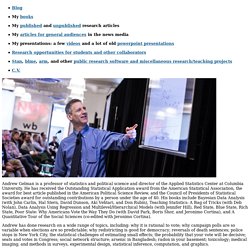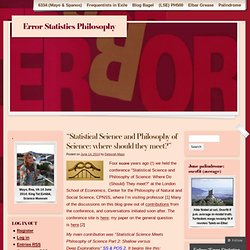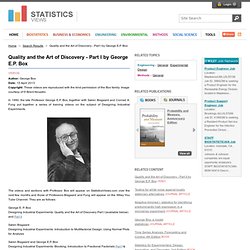

(21) Statistics 110: Probability. Probability Web. Advanced Statistical Inference Calendar - Fall & Spring 2005. Teaching Assistant: 黃信雄 Email: r93221018@ntu.edu.tw Office hours: Friday afternoon 小 考 ( 2 0%) The objective of this course is to introduce to the students some basic theory of probability. It is fundamentally important for understanding the commonly used statistical concepts and methods. It also provides a necessary basis for students for a further study of other advanced statistical courses.
Fall semester: 1. 2. 3. 4. 5. 6. Spring semester Chapter 7: (4 weeks) Point Estimation Chapter 8: (3 weeks) Test of hypothesis Normal test, chi-square test, likelihood ratio test, Neyman-Pearson Lema, Bayesian test, UMP test and UMPU test Chapter 9: (2 weeks) Interval estimation. Andrew Gelman, Department of Statistics and Department of Political Science, Columbia University. Andrew Gelman is a professor of statistics and political science and director of the Applied Statistics Center at Columbia University.

He has received the Outstanding Statistical Application award from the American Statistical Association, the award for best article published in the American Political Science Review, and the Council of Presidents of Statistical Societies award for outstanding contributions by a person under the age of 40. His books include Bayesian Data Analysis (with John Carlin, Hal Stern, David Dunson, Aki Vehtari, and Don Rubin), Teaching Statistics: A Bag of Tricks (with Deb Nolan), Data Analysis Using Regression and Multilevel/Hierarchical Models (with Jennifer Hill), Red State, Blue State, Rich State, Poor State: Why Americans Vote the Way They Do (with David Park, Boris Shor, and Jeronimo Cortina), and A Quantitative Tour of the Social Sciences (co-edited with Jeronimo Cortina).
Statistical Modeling, Causal Inference, and Social Science - Andrew Gelman, Department of Statistics and Department of Political Science, Columbia University. ProbabilityManagement.org. Ward Whitt - Publications. Roe Goodman: Home Page. “Statistical Science and Philosophy of Science: where should they meet?” Four score years ago (!)

We held the conference “Statistical Science and Philosophy of Science: Where Do (Should) They meet?” At the London School of Economics, Center for the Philosophy of Natural and Social Science, CPNSS, where I’m visiting professor [1] Many of the discussions on this blog grew out of contributions from the conference, and conversations initiated soon after. The conference site is here; my paper on the general question is here.[2] My main contribution was “Statistical Science Meets Philosophy of Science Part 2: Shallow versus Deep Explorations” SS & POS 2.
It begins like this: 1. Overheard at the comedy hour at the Bayesian retreat: Did you hear the one about the frequentist… “who defended the reliability of his radiation reading, despite using a broken radiometer, on the grounds that most of the time he uses one that works, so on average he’s pretty reliable?” Or 2. Statisticians do, from time to time, allude to better-known philosophers of science (e.g., Popper). Project Euclid - mathematics and statistics online. R Dynamic System Model.
Alan Wan's research. Surveys Exploring The Current State of Information Technology Practices. 1D Interface Statistical Distributions. Text data editor Cut-and-paste text or edit data here This data is provided as an example, cut and paste as needed to model your data.

All lines of text that do not begin with a number are ignored. Free Stats Books, Classes & Exercises. Statistics Resources. Quality and the Art of Discovery - Part I by George E.P. Box - Statistics Views. In 1990, the late Professor George E.P.

Box, together with Søren Bisgaard and Conrad A. Fung put together a series of training videos on the subject of Designing Industrial Experiments. The videos and sections with Professor Box will appear on StatisticsViews.com over the next few months and those of Professors Bisgaard and Fung will appear on the Wiley You Tube Channel.
They are as follows: George E. Søren Bisgaard Designing Industrial Experiments: Introduction to Multifactorial Design; Using Normal Plots for Analysis Søren Bisgaard and George E.P. Conrad A. Conrad A. Home - Statistics Views. Statistics Lectures.